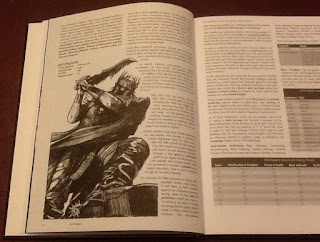I was a little sad the other night, when Brick, the party's Halfling, got turned into a Brickcicle by a freezing blast of dragon breath. It truly was a case of him being in the wrong place at the wrong time; the player figured the halfling was out of harm's way down a hall, away from the fight, not realizing that dragon breath would travel some 80' down the passage. It was one of those absurd D&D deaths that underlines the randomness of the game. The guys that charged the dragon's teeth, banzai style, all made it through. War is hell.
As the referee, it's important to maintain an impartial demeanor, but that doesn't mean we can't feel bad when something unfortunate happens to the players through poor luck. In this case, the players just missed identifying the extent of the risk. But there are truly selfish reasons why I'm going to miss that party halfling. Consider the following a spirited defense of the class.
Halflings bring two important and complimentary elements to the adventuring party; world class Scouting ability and Durability. This makes them the ultimate trailblazers.
Let's first look at the importance of scouting. Most of my favorite moments as a game master are when the party is confronted with a difficult situation, a tough tactical challenge or tricky puzzle, and all the players are forced to lean in a little closer, hovering over the map, planning their way forward through difficult choices. I can't count how many of those situations emerged directly from the halfling's ability to creep forward, stealthily, and return with valuable information about the disposition of the enemy (it seemed like that happened almost every game). We've been spoiled, perhaps, by the LOTFP flavor of the halfling, which emphasizes halfling stealth even more than Moldvay's BX rules.
Information is the lifeblood of player planning and strategy; it cannot be overstated how valuable it is to have a competent scout, even though we don't normally view it as an important character role or niche. Not only is the poor thief abysmal at stealth during the low levels, he is further saddled with poor saving throws and weak hit points, making him a tough choice for risky scouting missions.
Which highlights the other under-appreciated value of those 4' tall crumb-snatching halflings; their amazing saving throws and durability. Part and parcel of scouting ahead is a willingness to put your character in mortal danger, particularly when you get jumped by something that forces a saving throw. And nothing brings the game to a halt like haggling over who is going to test some risky dungeon element, like sipping the unidentified potion, seeing if the trap was successfully deactivated, looking at the scroll to see if it was cursed, or "touching that thing and seeing what happens". The halfling is perfect for those risk-taking instigators in the party.
So this is my selfish confession as a DM; I like halflings in the game, because their scouting prowess gives me frequent opportunities to give the players insider information, and their hardiness emboldens the players to take risks and test more dicey situations during exploration. Both are powerful net positives and important party roles.
Alas, the halfling love is not universal. For instance, ACKS has omitted the halfling class. Here's what Alex had to say on the matter back when ACKS was in development:
Halfings were created by JRR Tolkien specifically as an example of a race that was NOT good at adventuring. That's their whole point in the story; they are the unlikeliest heroes imaginable, the meek, the average, the overlooked. But because the Fellowship of the Ring was the original adventuring party, and it had halflings, every RPG since has riffed on Tolkien and made halflings one of the core adventuring races -- missing the entire point. When a game includes halflings, they are aping the trappings of our fictional sources without understanding their context. Thus I refuse to make halflings a core playable race in ACKS for this reason!!
-Alex, game designer and confessed halfling haterI'm a big fan of those Autarch products, but clearly, Alex has it all wrong on the utility of the these guys. It seems like a good time for a new poll. Be a kind soul and let me know how you feel about the grubby, shoeless, little mugs in the latest poll.










